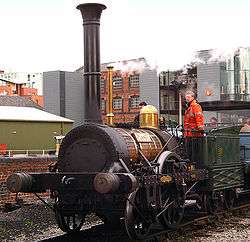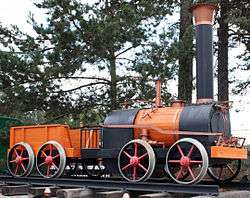2-2-0


.jpg)
Under Whyte notation for the classification of steam locomotives, 2-2-0 represents the wheel arrangement of two leading wheels on one axle, two powered driving wheels on one axle, and no trailing wheels. This configuration, which became very popular during the 1830s, was commonly called the Planet type after the first locomotive, Robert Stephenson's Planet of 1830.
Equivalent classifications
Other equivalent classifications are:
- UIC classification: 1A (also known as German classification and Italian classification)
- French classification: 110
- Turkish classification: 12
- Swiss classification: 1/2
History
Great Britain
After early experience with the 0-2-2 configuration on the Liverpool and Manchester Railway, Robert Stephenson decided to build a locomotive with cylinders inside the frames, for which a 2-2-0 was preferable.[1] The first such locomotive was Planet, built in 1830 and the company went on to build a further eighteen examples for the railway. In 1835 five examples were supplied to the London and Greenwich Railway.[2] After 1836 Edward Bury built sixty-nine bar frame 2-2-0 locomotives for the London and Birmingham Railway.[3] The steam roller and traction engine company Aveling and Porter built a number of 0-2-2 locomotives, some of which were convertible traction engines.[4]
North America
Tom Thumb, the first American-built steam locomotive used on a common-carrier railroad, built by Peter Cooper in 1830 was a belt-driven 2-2-0, but the type was not perpetuated.
Ireland
The Dublin and Kingstown Railway used 2-2-0 in 1834 including Hibernia designed by Richard Roberts and built by Sharp, Roberts and Company, and Vauxhall built George Forrester and Company.[5]
Russia
The first Russian-built steam locomotive was a 2-2-0 built by the Cherepanovs (father and son) in 1833-1834.[6]
Decline of the 2-2-0
By 1840 the 2-2-0 tender type had largely been superseded by the 2-2-2 configuration. However, there are a few examples of later tank engines, thus William Bridges Adams of the Fairfield Locomotive Works (51°31′52″N 0°01′19″W / 51.5312°N 0.0219°W) in Bow supplied a 2-2-0 well tank to the Roman Railway in 1850.[7] Also Dugald Drummond of the London and South Western Railway introduced his C14 class 2-2-0T in 1906, for Auto trains, but this design was not successful and several of the locomotives were rebuilt to 0-4-0.
References
- ↑ The Victorian Web http://www.victorianweb.org/technology/railways/l4.html .
- ↑ Bertram Baxter, British Locomotive Catalogue 1825-1923, Moorland Publishing, 1977, p.67.
- ↑ Bertram Baxter, British Locomotive Catalogue 1825-1923, Moorland Publishing, 1977, p.7.
- ↑ Yeatman, D. (December 1966), "Lodge Hill & Upnor Railway", The Industrial Railway Record, Industrial Railway Society, Vol 1 (Issue 12), pp. 277–292, retrieved 21 August 2012
- ↑ Science Museum, The British Railway Locomotive 1803-1853, H.M.S.O., 1958. pp.12-13.
- ↑ Le Fleming, H.M. and Price, J.H. Russian Steam Locomotives, p 23, John Marshbank Ltd, London, 1960
- ↑ Hamilton Ellis, The pictorial history of railways, Hamlyn, 1968, p.58.